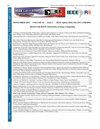使用眼动追踪和使用语言模型的单词推荐的辅助和替代交流
IF 1.3
4区 工程技术
Q3 COMPUTER SCIENCE, INFORMATION SYSTEMS
引用次数: 0
摘要
信息的生产、存储和传播已经从古老的通信方式发展到现代数字技术,数字媒体在连接个人方面发挥着关键作用。虽然键盘是常用的交互工具,但它们对有运动障碍的人来说是一种挑战。增强和替代通信(AAC)技术,包括手势输入、语音命令和基于传感器的系统,已经出现,以解决这些限制。在辅助系统中使用的眼动追踪带来了机遇和挑战,比如视觉疲劳和不准确导致打字速度变慢。为了解决这些挑战,本研究提出了一种将眼动跟踪与虚拟键盘相结合的交互方法,利用人工神经网络以低成本为用户解释注视数据并翻译界面内的意图。此外,语言模型(LM)有助于预测下一个单词的建议。本研究将评估这些技术对打字速度、错误率和语言可预测性的影响,为无障碍通信系统的进步做出科学和社会贡献。本文章由计算机程序翻译,如有差异,请以英文原文为准。
Augmentative and Alternative Communication Using Eye Tracking and Word Recommendation Using Language Models
The production, storage, and dissemination of information have evolved from ancient communication methods to modern digital technologies, with digital media playing a key role in connecting individuals. While keyboards are common tools for interaction, they present challenges for individuals with motor impairments. Augmentative and Alternative Communication (AAC) techniques, including gesture input, voice commands, and sensor-based systems, have emerged to address these limitations. Eye tracking, used in accessibility systems, offers both opportunities and challenges, such as visual fatigue and inaccuracies that lead to slower typing. To address these challenges, this study proposes an interaction approach integrating eye movement tracking with a virtual keyboard, utilizing an artificial neural network to interpret gaze data and translate intentions within the interface at a low cost for the user. Additionally, a Language Model (LM) aids in predicting next-word suggestions. This research will assess the impact of these technologies on typing speed, error rate, and linguistic predictability, contributing both scientifically and societally to the advancement of accessible communication systems.
求助全文
通过发布文献求助,成功后即可免费获取论文全文。
去求助
来源期刊

IEEE Latin America Transactions
COMPUTER SCIENCE, INFORMATION SYSTEMS-ENGINEERING, ELECTRICAL & ELECTRONIC
CiteScore
3.50
自引率
7.70%
发文量
192
审稿时长
3-8 weeks
期刊介绍:
IEEE Latin America Transactions (IEEE LATAM) is an interdisciplinary journal focused on the dissemination of original and quality research papers / review articles in Spanish and Portuguese of emerging topics in three main areas: Computing, Electric Energy and Electronics. Some of the sub-areas of the journal are, but not limited to: Automatic control, communications, instrumentation, artificial intelligence, power and industrial electronics, fault diagnosis and detection, transportation electrification, internet of things, electrical machines, circuits and systems, biomedicine and biomedical / haptic applications, secure communications, robotics, sensors and actuators, computer networks, smart grids, among others.
 求助内容:
求助内容: 应助结果提醒方式:
应助结果提醒方式:


